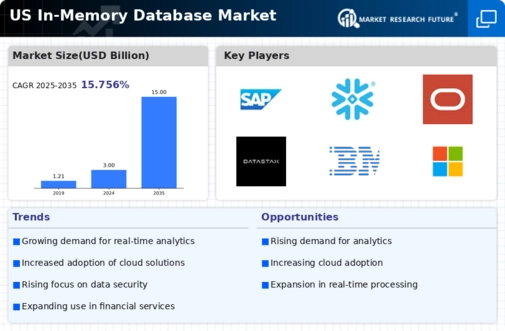The US In-Memory Database Market is characterized by a rapidly evolving landscape due to the increasing demand for real-time data processing and analytics across various industries. As companies strive to enhance operational efficiencies and deliver immediate insights from vast data volumes, numerous players are entering this space with innovative solutions. This market is becoming increasingly competitive, with established firms and emerging startups alike vying for market share by offering advanced technologies that cater to the distinct requirements of businesses.
The shift towards cloud computing and a growing emphasis on artificial intelligence and machine learning only propels the demand for in-memory databases, enhancing the competitive nature of the market.SAP holds a significant position in the US In-Memory Database Market with its robust technology stack designed to support complex business applications. Known for its flagship product, SAP HANA, the company has solidified its market presence by offering high-performance analytics and data processing capabilities that cater to various sectors, including finance, retail, and manufacturing.
SAP demonstrates strengths such as its established customer trust, extensive ecosystem of partners, and continuous innovation through research and development. Consequently, its ability to integrate with other SAP solutions positions it favorably against competitors, allowing businesses that adopt SAP’s in-memory solutions to benefit from improved scalability, speed, and data management efficiency.VoltDB has carved out a specialized niche within the US In-Memory Database Market by focusing on high-velocity transaction processing and analytics. The company’s primary offerings center around its flagship in-memory database, which emphasizes scalability and resilience.
VoltDB leverages emerging technologies to provide solutions tailored for specific industries such as telecommunications and e-commerce, addressing real-time data needs effectively. The company’s strengths lie in its ability to support large data sets and deliver ultra-fast processing speeds, making it attractive for organizations looking to manage critical workloads. Further enhancing its market position, VoltDB has engaged in strategic partnerships and potential mergers and acquisitions, bolstering its portfolio and expanding its reach in the highly competitive US market, ultimately offering a robust alternative to existing players.





















